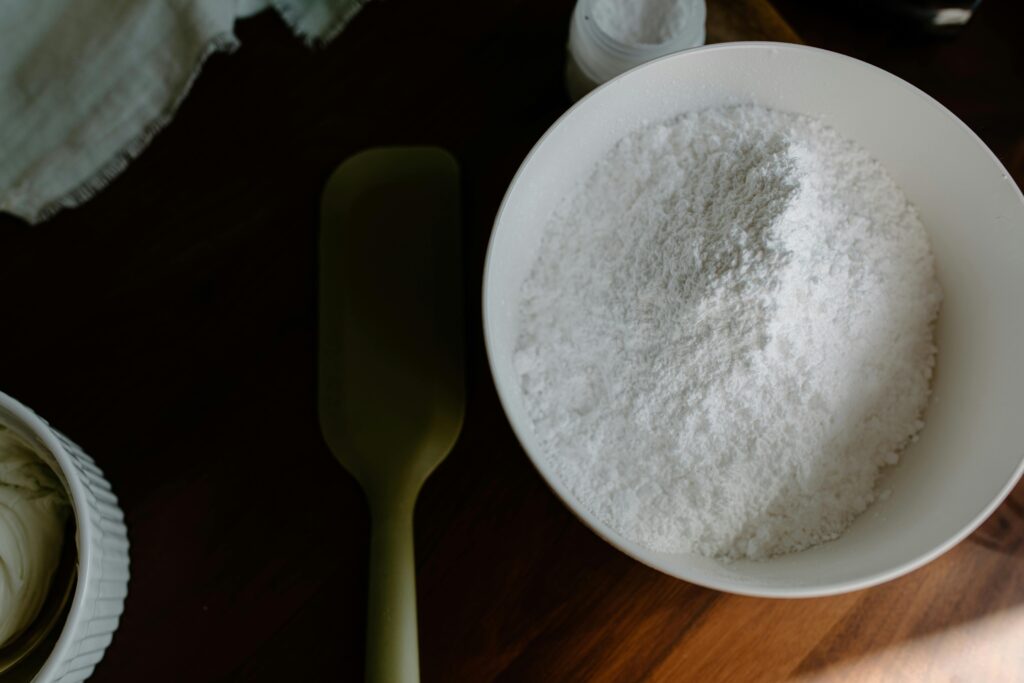What is baking powder?
Baking powder is a leavening agent composed of powdered sodium bicarbonate and an equivalent amount of an acid-reacting substance, typically derived from cream of tartar, tartaric acid, mono-calcium phosphate, or sodium aluminum sulfate. This carefully balanced mixture is often diluted with dry starch to achieve a consistent texture and contains approximately 13 to 14 percent “available” carbon dioxide. This gas is essential for creating bubbles in baking dough, facilitating the rise of baked goods and ensuring a light and fluffy texture.

Acids or acid components used in baking:
Phosphate Baking Powder:
- Some baking powders use only one acid-reacting substance, known as a “straight” powder.
- A well-known “straight” powder available in stores is made with calcium acid phosphate, often called Phosphate baking powder.
Tartrate Baking Powder:
- Another type of baking powder is made solely with cream of tartar, sold by specific wholesale distributors.
- All nationally advertised powders containing cream of tartar also include tartaric acid, known as tartrate powders.
Combination Baking Powder:
- This type of powder combines calcium acid phosphate and sodium aluminum sulfate.
- Referred to as a combination baking powder or “double-acting” powder, it is a popular choice in the United States, combining different ingredients for effective leavening.
Formulation of baking powder in baking:

- Calculation of Baking Powder Formula:
- The desired percentage of available carbon dioxide guides the formulation of baking powder.
- A proportion is established between the combining weights of carbon dioxide and sodium bicarbonate.
- For example, if 14 percent available carbon dioxide is required, the proportion would be 44 units of carbon dioxide to 84 units of sodium bicarbonate.
- This ratio determines the amount of sodium bicarbonate needed in the baking powder formulation.
- Ingredients and Formulation:
- Baking powder typically comprises sodium bicarbonate and an acid-reacting substance, like cream of tartar.
- The required amounts of sodium bicarbonate and acid are calculated based on the desired carbon dioxide content.
- For example, to achieve 14 percent available carbon dioxide, 26.73 pounds of sodium bicarbonate and an equivalent weight of acid-reacting material are combined.
- These ingredients are mixed with dry starch to make up the final product.
- Variations in Formulation:
- Different types of baking powder utilize varying acid-reacting substances, such as cream of tartar, tartaric acid, or a combination of calcium acid phosphate and sodium aluminum sulfate.
- The formulation ratios differ based on the chosen acid and their specific reactions with sodium bicarbonate.
- Manufacturers may adjust the formula slightly to optimize baking performance and product stability, often incorporating a slight excess of soda for practical purposes.
Effect of baking powder on flavor of baked products:
- Baking powder’s impact on flavor arises from its reaction products, not its original components, predominantly forming sodium salts of acids during leavening.
- Foods leavened with baking powders producing only tartrates and phosphates generally exhibit no adverse flavor effects, maintaining palatability.
- Some baking powders, such as straight Sodium Aluminum Sulfate (SAS) and phosphate-SAS combinations, may impart a subtle salty taste, possibly due to sodium sulfate, a residual reaction product.
- Despite variations in flavor perception, consumers typically do not detect undesirable tastes in products leavened with Sodium Aluminum Sulfate (SAS)-containing baking powders, suggesting comparable flavor outcomes across different types of baking powders.
Baking powder or baking soda?
Sodium bicarbonate is the top choice among baking powder ingredients for producing carbon dioxide, which is what helps baked goods rise. Since it’s used so widely, there aren’t many alternatives to compare it with. We mainly judge its effectiveness based on its own characteristics, which are well-documented in inorganic chemistry textbooks. Its effects on the body and its nutritional value are also extensively covered in physiology and physiological chemistry texts.
Conclusion:
Baking powder plays a pivotal role in the world of baking, serving as a key leavening agent to make baked goods rise. Comprised mainly of sodium bicarbonate and acid-reacting materials, it releases carbon dioxide gas when mixed with moisture and heat, creating bubbles that lift dough and batter. The choice of baking powder type and formulation impacts the texture, flavor, and overall quality of baked products. Despite variations in ingredients and chemical reactions, baking powder remains a staple in both home kitchens and commercial bakeries, enabling the creation of light, fluffy, and delicious treats enjoyed worldwide.